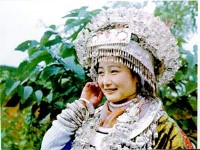 If you are fortunate enough to visit a Miao village during festivals or when the ethnic group holds marriage ceremonies, you will be dazzled by the varied and colorful costumes and silver ornaments of Miao women.
If you are fortunate enough to visit a Miao village during festivals or when the ethnic group holds marriage ceremonies, you will be dazzled by the varied and colorful costumes and silver ornaments of Miao women.
Miao festival clothes are appealing not only because of their unique styles and craftsmanship, but also because they reveal the rich Miao culture and its long history.
Traditional costumes of different branches of the Miao ethnic group vary, though the craftsmanship needed to make the costumes always reaches the peak of perfection. Usually, making a set of traditional Miao clothes takes a Miao woman 1-2 years.
More than 50 percent of Miao people live in Guizhou Province. In the Miao community, which has mostly been closed to the outside world, their religious beliefs are often thought of as primitive. The motivation behind Miao women’s hard work needed to make their clothes is their devotion to their ancestors. It has long been a tradition for Miao women to use embroidery and sewing to show how much they worship their ancestors.
Mountains and rivers make Miao areas difficult to access, which has lessened the impact of modern civilization and helped them to maintain old traditions. Some old costumes from Chinese history that were recorded in ancient books from the Han Dynasty (206BC-AD220)have long since disappeared in many parts of the country. However, one can still find such costumes in the Miao community. Some foreigners who have visited the Miao have called them “living terra cotta warriors.”
Without written script, Miao people have used their costumes to record their history. Different patterns and designs on the clothes retain rich meaning and refer to legendary stories about such things as their origins, wars and religious beliefs.
Because hand-made Miao costumes are sewn individually by Miao women in their homes, there are hardly two costumes with the same style or pattern.
The Miao hundred bird coat, originally worn on major occasions to worship ancestors, is now festival attire. The coat is big and loose with no collar. Hundreds of birds and dragons are embroidered on the front and back. It is made of 7-10 strips of bands with embroidered patterns of frogs, dragons, birds, butterflies and insects, symbols of the Miao’s mystic culture.
Silver ornaments make up an important part of Miao dress. Silver is believed by Miao people to be the symbol of light which can dispel evil spirits. When bathing a new born baby, parents often put a piece of silver into the water to act as a blessing for the baby’s future. Miao families also dress up their daughters with silver ornaments. During some occasions, silver worn by young women in their best clothes weighs more than 10 kg.
Miao girls begin to learn weaving, embroidery and cross stitching from the early age of 6 or 7. A girl often pours great energy into making an embroidered dress. When she finishes the dress for herself, she shows she is ready to marry. The dress reveals the girl’s talent and ingenuity.
In some Miao areas a tradition of “secret embroidery” has been handed down to current generations. When girls reach the age of 15 they begin to make their “secret embroidery” behind closed doors. These secret works include small caps, shoes and "infant packs," which are prepared for the future when a woman gets married and has babies. This embroidery will be exhibited to the public at the girl’s wedding ceremony. Usually there are around 100 items to display.
Embroidery methods are varied and include “zhouxiu,” “sanxiu” and “duihua”. "Zhouxiu" is embroidery which is done by plaiting silk thread into braids, folding it on cloth and then fixing it with thread. The patterns of this embroidery create a striking decorative effect. Traditional Miao costumes for holidays are made using three methods which are called “bright clothes.” This involves a large amount of silver ornaments being fixed to clothing.
Miao women are also proficient in batik. The batik dyeing is meticulous and a long-standing tradition among the Miao. Their colored batiks are renowned at home and abroad.
(People’s Daily 02/22/2001)
